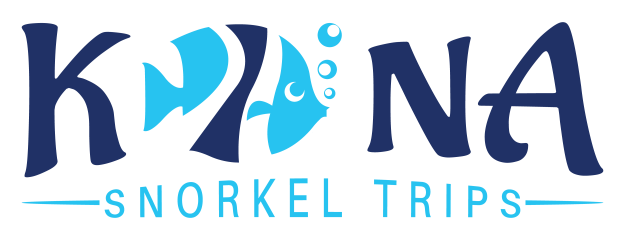Experience the Best Whale Watching Tours Kona Hawaii
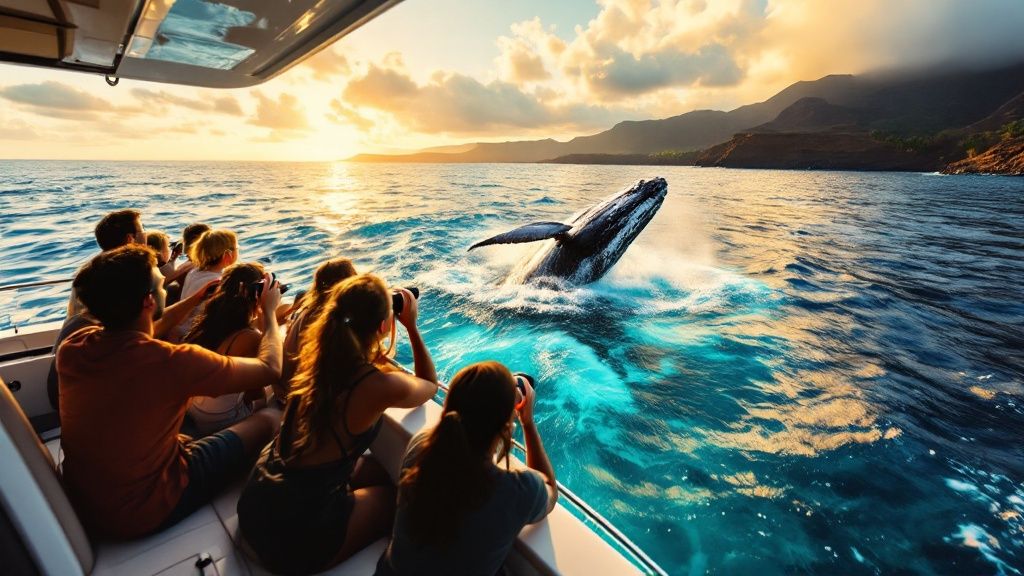
Picture this: the brilliant turquoise water off the Kona coast explodes as a forty-ton humpback whale shoots straight up out of the sea. It’s a breathtaking, heart-stopping moment, and it’s the core of what makes whale watching tours in Kona, Hawaii so unforgettable. If you're dreaming of seeing these gentle giants for yourself, you've come to the right place. This guide is your first step toward an incredible adventure.
Your Kona Whale Watching Adventure Starts Here
Any great ocean adventure begins with a trusted guide. As Hawaii's top-rated and most-reviewed snorkel company, we at Kona Snorkel Trips live and breathe these waters. We've built our reputation on creating memorable, respectful ocean encounters, always keeping our groups small so you get the best possible experience.
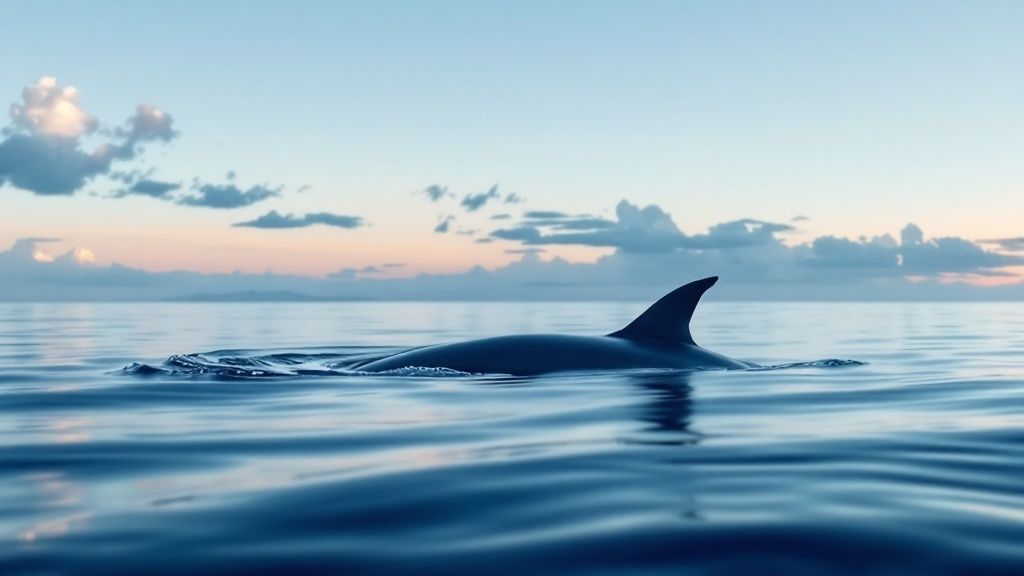
There's a reason the humpbacks choose the Big Island's western coast. The water here is calm, deep, and protected—the perfect nursery for them to breed, give birth, and raise their calves after their long journey from Alaska. It’s a whale sanctuary, plain and simple.
This unique setup gives us amazing opportunities to witness a whole range of whale behaviors, always from a respectful distance. You might see the powerful splash of a tail slap, hear the mysterious song of a male, or, if you're lucky, witness the awe-inspiring sight of a full breach. Every single moment on the water is filled with potential. Let's dive into what you need to know to make your trip a success.
Finding The Perfect Time For Your Whale Tour
Timing is everything if you want to have a truly unforgettable whale watching tour in Kona. Humpback whales aren't here year-round; they make an epic journey thousands of miles from the icy waters of Alaska, all the way to the warm, protected seas around Hawaii to give birth and raise their young. Nailing the timing of this annual migration is the real secret to an amazing trip.
The official whale season runs from December through April, but if you want to put the odds in your favor for some truly mind-blowing sightings, you'll want to aim for the absolute peak of the season. That sweet spot is from January through March.
During these months, the Kona coast is practically buzzing with whale activity. It's not uncommon to see multiple pods of whales every single day. We're talking about everything from the show-stopping, powerful breaches clear out of the water to the quiet, tender moments between a mother and her newborn calf.
To help you plan, here's a simple breakdown of what to expect month by month.
Kona Whale Watching Season At a Glance
This table breaks down the whale watching season month-by-month, helping you decide the best time for your tour.
| Month | Whale Activity Level | Typical Sightings |
|---|---|---|
| December | Moderate | The first arrivals from Alaska start showing up. Sightings are good but not guaranteed. |
| January | High | Activity ramps up significantly. Pods are common, and you might see competitive behaviors. |
| February | Peak | The absolute best month. The highest concentration of whales, with lots of calves. |
| March | High | Still peak season, with tons of activity as mothers teach their calves essential skills. |
| April | Moderate | Whales begin their journey back north. Sightings become less frequent by the end of the month. |
As you can see, planning your trip between January and March gives you the best shot at seeing these incredible animals.
Morning Calm Or Afternoon Action
Another thing to think about is whether you prefer a morning or an afternoon tour, as it can shape your experience on the water.
Early morning trips often have the calmest ocean conditions. The water can be like glass, which makes it much, much easier to spot those tell-tale spouts on the horizon. In our experience, tours that head out first thing in the morning often report more sightings than trips later in the day.
The Kohala coast, just north of Kona, is a real hotspot. We often see two to three times more whales there than in other spots around the island. Mornings are king, with roughly 50% higher sighting rates than midday thanks to the calm seas and increased whale activity near the surface.
While the mornings offer that crystal-clear water, afternoon trips have their own kind of magic. The changing light can make for some stunning photos, and the whales can be just as active. It really just comes down to whether you prefer smoother seas or a more dramatic, golden-hour backdrop for your adventure.
You can learn even more about what to expect by checking out our complete guide to the Big Island whale season.
What To Expect On Your Day At Sea
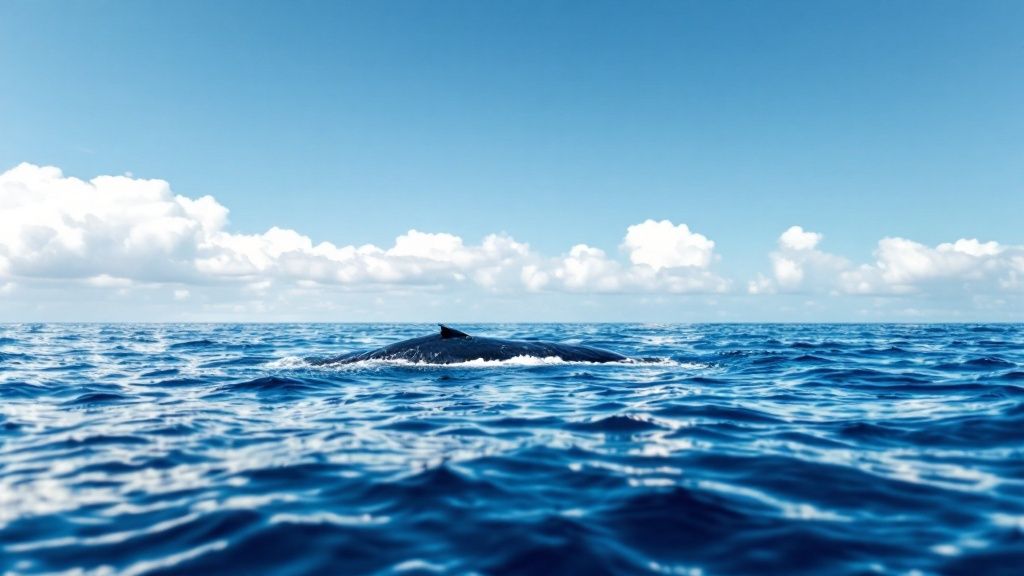
Your day kicks off with a warm aloha and a quick safety chat from the crew. As soon as you're out on the water, the real adventure starts—everybody's eyes are glued to the horizon, waiting for that very first sign: a misty spray shooting up to 15 feet into the sky.
The vibe of your tour can really change depending on the boat you pick. A big, roomy catamaran gives you a super stable ride and lots of space to wander around. On the other hand, a smaller, quicker raft gets you right down near the surface for a more personal, eye-to-eye experience. Either way, the rush of spotting a whale is exactly the same.
Witnessing Incredible Whale Behaviors
Every whale watching tour in Kona, Hawaii has a seasoned marine naturalist on board. Think of them as your personal translator for the whale world. They're amazing at pointing out the subtle behaviors and turning a simple sighting into an unforgettable story.
Have that camera ready for these classic moments:
- Breaching: This is the showstopper. A whale hurls its entire 40-ton body right out of the water. It’s breathtaking.
- Tail Slaps: You'll see a powerful smack of the fluke on the surface. We think it's one of the ways they talk to each other.
- Spy-hopping: This is when a whale pops its head straight up out of the water, almost like it's trying to get a better look at you.
But some of the most powerful moments happen when you just listen. Many tours will drop a hydrophone—an underwater microphone—into the ocean. Hearing the complex, haunting songs of the male humpbacks echoing up from the deep is something you'll never forget.
How To Choose The Right Kona Whale Tour
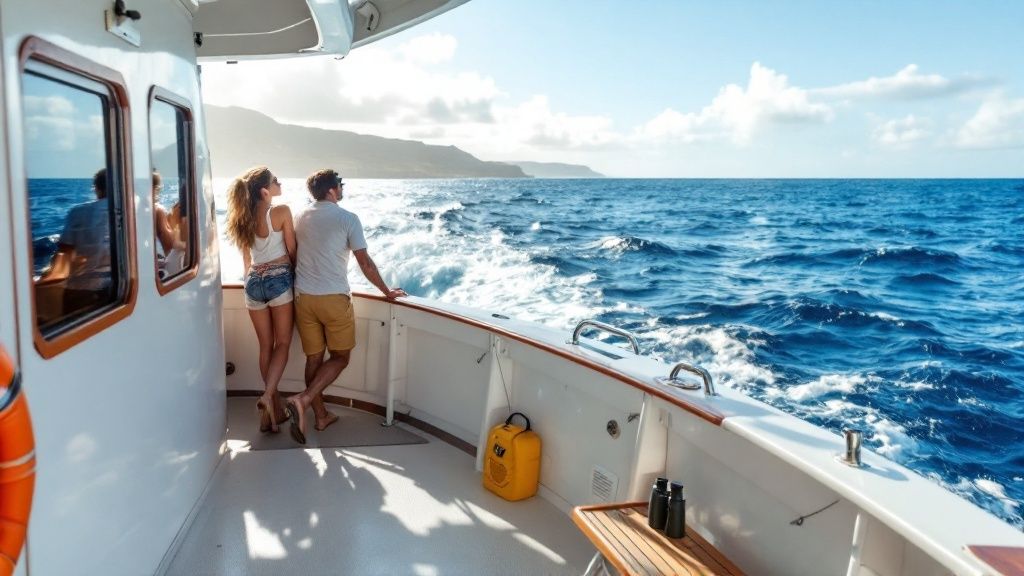
With so many incredible whale watching tours Kona Hawaii has on tap, picking the perfect one really boils down to your personal style and what you're hoping to get out of the day. The experience can be wildly different depending on the boat you're on, so it's worth thinking about the key differences.
Big, spacious catamarans offer a super stable and comfortable ride with plenty of room to walk around. They usually have great amenities like shaded seating and restrooms, which makes them a fantastic choice for families with kids or anyone who just wants a more relaxed journey on the water.
On the flip side, you have the smaller, zippier zodiac-style rafts. These boats deliver a much more intimate and adventurous trip. You're right down at the water's surface, getting a thrilling, eye-level view of the whales. They're ideal for photographers and anyone seeking a more up-close-and-personal encounter.
Factors To Compare
Before you book, take a moment to think about what's most important for your group. A little bit of planning goes a long way in making sure your day on the water is everything you imagined.
- Tour Length: Most trips run between 2 to 4 hours. A longer tour gives you more time to find the whales and just watch them in their natural habitat without feeling rushed.
- Group Size: Smaller groups almost always mean a more personal experience. You'll have better chances to chat with the naturalist guide and ask all your burning questions.
- Onboard Features: One of the coolest features to look for is a hydrophone. The crew drops this underwater microphone into the ocean, letting you listen to the haunting, complex songs of the humpback whales. It's a truly unforgettable experience.
Whale Watching With Respect and Responsibility
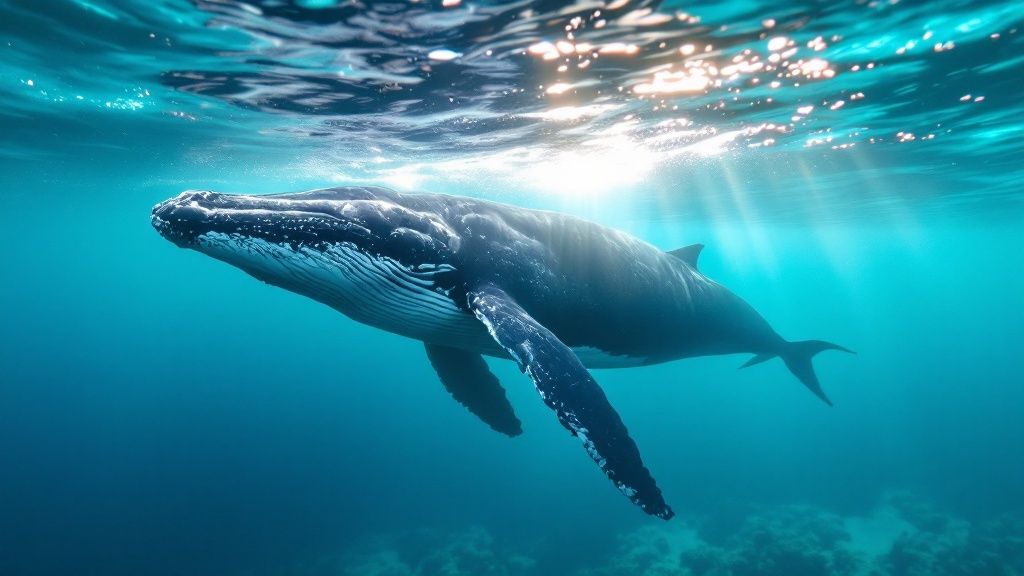
Seeing humpback whales in their natural nursery is a powerful experience, an absolute privilege that comes with a shared duty of care. Every ethical whale watching tour in Kona, Hawaii is built on a foundation of deep respect for these magnificent animals and the ocean they call home. This isn't just a friendly suggestion—it’s the law.
Federal regulations are strictly enforced to protect the whales, requiring all boats to keep a safe distance of at least 100 yards. This buffer zone is crucial. It prevents us from stressing the whales and allows them to go about their essential business—like mothers nursing their calves or simply resting—without being disturbed by our presence.
When you choose a responsible tour operator, you become an active participant in the conservation of this incredible species. It makes your adventure a positive force for the ocean.
Supporting Conservation and Research
Your tour ticket does more than just buy you incredible memories; it actually fuels a much larger ecosystem of research and protection. Many local conservation initiatives rely on the eyes and ears of tour operators out on the water to monitor the health and behavior of the whale population.
These efforts are backed by amazing community science projects. For example, local organizations coordinate one of the world’s longest-running volunteer whale counts, which provides vital data for tracking population trends and getting the public involved. To get a better feel for responsible viewing practices, check out our complete guide on whale watching on the Big Island.
Your Kona Whale Watching Questions Answered
To make sure you're totally ready for your day on the water, we've put together answers to the questions we hear most often about whale watching tours in Kona, Hawaii. Getting the details straight beforehand means you can just relax and soak in the experience.
What Should I Bring on a Whale Watching Tour?
A little preparation goes a long way in making your trip comfortable. We always tell people to think about sun protection first.
- Reef-safe sunscreen is a must.
- A good hat that won't fly off.
- Polarized sunglasses are a game-changer for cutting the glare on the water.
It can also get a bit chilly with the ocean breeze, even on a sunny day, so packing a light jacket or windbreaker is a smart move. And of course, don't forget your camera or phone! If you know you're prone to seasickness, it's always best to take your preferred remedy before you get on the boat.
Is a Whale Sighting Guaranteed?
Here's the honest answer: these are wild animals on their own schedule, so no tour can ever promise a sighting with 100% certainty. It’s just not how nature works.
That said, during the peak season from January to March, your chances are incredibly high. Experienced crews know where to look and have a knack for finding them. Many of the best companies offer a "whale guarantee"—if you don't see any whales, they'll let you come back another day for free.
How Close Will We Get to the Whales?
Respecting the whales' personal space is everything. Federal law is very clear: all boats must stay at least 100 yards away to make sure we don't disturb them.
But the cool thing about humpbacks? They're often just as curious about us as we are about them. It's not uncommon for them to approach the boat on their own, sometimes getting surprisingly close. Those moments are always on their terms, making for some truly breathtaking and respectful encounters.
For a deeper dive into what to expect on the water, check out our complete guide to whale watching in Kona.
Ready for an ocean adventure you'll never forget? Book your tour with Kona Snorkel Trips and see the magic of Hawaii's gentle giants for yourself.
